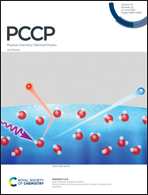Solvation stabilizes intercarbonyl n→π* interactions and polyproline II helix†
Abstract
n→π* interactions between consecutive carbonyls stabilize the α-helix and polyproline II helix (PPII) conformations in proteins. n→π* interactions have been suggested to provide significant conformational biases to the disordered states of proteins. To understand the roles of solvation on the strength of n→π* interactions, computational investigations were conducted on a model n→π* interaction, the twisted-parallel-offset formaldehyde dimer, as a function of explicit solvation of the donor and acceptor carbonyls, using water and HF. In addition, the effects of urea, thiourea, guanidinium, and monovalent cations on n→π* interaction strength were examined. Solvation of the acceptor carbonyl significantly strengthens the n→π* interaction, while solvation of the donor carbonyl only modestly weakens the n→π* interaction. The n→π* interaction strength was maximized with two solvent molecules on the acceptor carbonyl. Urea stabilized the n→π* interaction via simultaneous engagement of both oxygen lone pairs on the acceptor carbonyl. Solvent effects were further investigated in the model peptides Ac-Pro-NMe2, Ac-Ala-NMe2, and Ac-Pro2-NMe2. Solvent effects in peptides were similar to those in the formaldehyde dimer, with solvation of the acceptor carbonyl increasing n→π* interaction strength and resulting in more compact conformations, in both the proline endo and exo ring puckers, as well as a reduction in the energy difference between these ring puckers. Carbonyl solvation leads to an energetic preference for PPII over both the α-helix and β/extended conformations, consistent with experimental data that protic solvents and protein denaturants both promote PPII. Solvation of the acceptor carbonyl weakens the intraresidue C5 hydrogen bond that stabilizes the β conformation.



 Please wait while we load your content...
Please wait while we load your content...